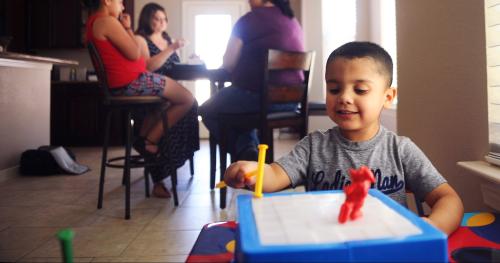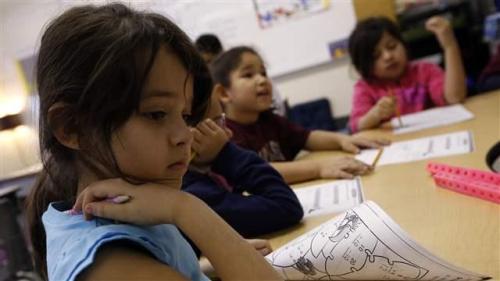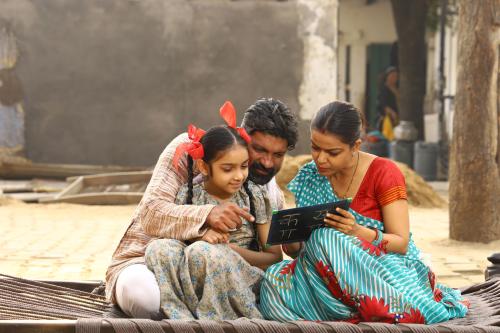Early childhood education programs across the United States are more academic than ever before. Although new research shows that this “academization” produces positive performance gains, experts debate if this trend hinders the social and emotional development of our youngest learners. But must this choice between “soft skills” and academic development be seen through a binary lens?
Rather than approaching these discussions as mutually exclusive models of pre-K programs, let’s consider the benefits of integrating social and emotional learning (SEL) within the increasingly common model of academic early childhood education. By targeting elements of student emotional development that affect classroom environment, like student behavior and student-teacher interaction, SEL may actually support and promote growth from academic instruction for early childhood students.
Academic instruction and performance gains
New research by Bruce Fuller and colleagues finds that preschools centered on oral language, pre-literacy, and math skills improved the effects of early childhood education in young children more than less academically oriented preschools. Most notably, African-American students living in poverty gained the most from academic preschool experiences.
Note that the “academic preschools” in the study were those that reported frequent time spent on specific pre-literacy and numeracy tasks—daily or close to it. Though not explicitly described in the study, non-academic classrooms presumably were more play or activity focused, facilitated by a teacher. Class time spent on SEL could not be measured in the study, and it is possible that it could be incorporated at different levels throughout both academic and non-academic programs.
Although the study seems decisively supportive of academic preschools, especially for low-income minority students, the authors’ call for more research on SEL growth is a crucial component of the study. In their words, “More work is required to better understand how related dimensions of instructional organization, including the character of teacher and child interactions, may interact with academic activities to advance youngsters’ social-emotional growth.”
The authors’ call for more in-depth research on the subject is warranted, and it opens the conversation for the value of integrating SEL within academic early childhood settings. As the authors suggest, the direct academic advantages of SEL among early childhood students studied far less often than the well-documented benefits for students in elementary and secondary school. However, studies on SEL’s effect on student behavior and student-teacher interactions provide reason for optimism that SEL in an early childhood environment can cultivate academic growth.
SEL can support academic growth
SEL has been shown to promote students’ development in managing emotions, achieving goals, and relating to others. For early childhood students today, these so-called soft skills do not remain on the playground but follow them into the classroom. Benefits like stress management and emotion regulation may support a young student’s ability to learn from direct instruction, complementing the learning benefits of an academic preschool. In one study of 255 ethnically diverse preschool students, a child’s self-control at age four was directly correlated to his or her math scores in first grade. Extrapolating this result, learning SEL skills in early childhood classrooms may help a variety of young students enrich their academic learning experiences in subsequent years.
SEL not only affects behavior but also influences relationships, and the student-teacher relationship is vital to a student’s academic success in an early childhood classroom. Presumably, this relationship is even more critical in academic early childhood programs as students spend more time learning directly from teachers, rather than through play or from other students. SEL supports the creation of strong ties between students and teachers. By engaging with students through the best practices of SEL instruction, like problem solving and supportive listening, teachers can improve their relationship with students while also modeling positive behaviors. Notably, SEL instruction has shown to be more effective when learned from a teacher, rather than a larger school initiative.
These behavioral and interpersonal benefits of SEL may develop simultaneously in early childhood classrooms. One study of SEL on preschool students found benefits for both student behavior and their relationships with teachers. In this study, teachers reported that SEL instruction created a significant decrease in behaviors that disrupted classroom learning while their relationships with students improved, hinting at a productive interaction between the two.
Challenges to SEL in early childhood
It is important to note that the implementation of SEL programs in early childhood academic classrooms does not come without its challenges.
First, a common critique of promoting “soft skills” in classrooms is that these are luxury skills—in other words, demanded by those whose kids are already doing well on literacy and numeracy, and who therefore have the luxury of pursuing development in other areas. Consider that Fuller found that academic instruction in preschool provides the strongest gains for low-income minority students; therefore, shouldn’t we worry that they have the greatest risk of losing out by shifting focus away from academics in favor of SEL?
The rebuttal, though, is that emerging research seems to suggest a complementarity, not a substitution between these dimensions. At nine months old, low-income students are behind not only on cognitive but also on social-emotional skills. SEL instruction can lessen the degree to which developmental delays hinder a child’s academic growth. A joint Brookings and AEI consensus report recommends SEL as one of the best ways to improve educational outcomes for low-income children. Thus, for those students most affected by academic instruction, notably African-American students living in poverty, SEL could theoretically enhance these gains even more.
Second, we need to consider the demand of teaching SEL skills on the early childhood teacher workforce. Due to low licensing and education requirements, the teacher workforce for early childhood education is largely underpaid and underqualified. The nuances of teaching social and emotional learning will certainly require more, perhaps much more, training and professional development among this group of dedicated educators. This logistical and financial burden may threaten the feasibility of these efforts to expand social and emotional learning in some locales, and we encourage states to pay close attention to this.
Finally, one must consider the cost of time and resources to implement SEL in early childhood classrooms. The direct costs to states in providing training to pre-K teachers to implement such a change at scale are not trivial, but can be worth it. A cost-benefit study conducted by Clive Belfield and coauthors at Columbia’s Teachers College examined a variety of SEL programs. One program the authors considered, Second Step, includes pre-K classrooms and cost approximately $440 per student, combining both the indirect cost of teachers’ time plus direct costs of training. The estimated benefits were nearly 10 times as large as the cost, but naturally, realized over a much longer time horizon.
Though investing today for a long-term return is easier said than done, the current political and economic climate seems to give momentum to these changes now. States now enjoy more flexibility to create new accountability policies due to the Every Student Succeeds Act. A recent report from the Learning Policy Institute argues the timing is right for states to create SEL-centered policies in K-12 classrooms, and this focus can spill over into early childhood classrooms as well. Together, these factors suggest now may be opportune for states to make a good faith effort on SEL.
Not an ‘add on’
While SEL in early childhood education prepares students with the self-actualization and interpersonal skills necessary to thrive as citizens within the world, it is important to consider how it may interact with academic instruction. This emerging evidence from preschools suggests that SEL instruction is not an add-on skill, but acts more like a catalyst for academic growth. If the challenges to implementation are appropriately attended to, SEL in early childhood classrooms shows enough promise to start seriously experimenting with.
Caitlin Dermody contributed to this post.






Commentary
ABCs and SEL: Integrating social and emotional learning into academic preschools
September 1, 2017